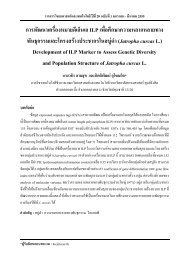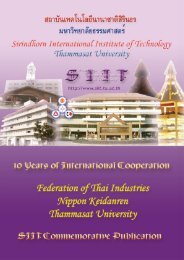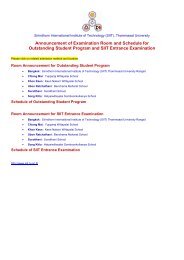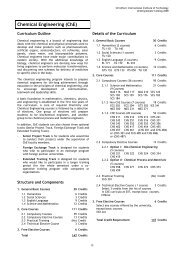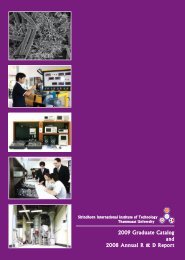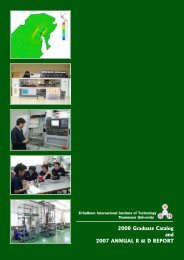2007 Graduate Catalog and 2006 Annual R & D Report - Sirindhorn ...
2007 Graduate Catalog and 2006 Annual R & D Report - Sirindhorn ...
2007 Graduate Catalog and 2006 Annual R & D Report - Sirindhorn ...
Create successful ePaper yourself
Turn your PDF publications into a flip-book with our unique Google optimized e-Paper software.
<strong>2007</strong> <strong>Graduate</strong> <strong>Catalog</strong> <strong>and</strong> <strong>2006</strong> <strong>Annual</strong> R & D <strong>Report</strong><br />
<strong>Sirindhorn</strong> International Institute of Technology (SIIT)<br />
Research Interests:<br />
Software for Optimization of the Tool-Path of<br />
Industrial Milling Robots<br />
Innovations in the field of mechanical engineering<br />
have enhanced the involvement of milling robots in<br />
various manufacturing processes. Nowadays,<br />
computer guided milling machines are employed to<br />
produce free-shape surfaces in mass manufacturing<br />
industries such as automobile, airplane, ship-building,<br />
etc. However, several physical phenomena, such as<br />
machine kinematics, thermal effects, static <strong>and</strong><br />
dynamic loading, <strong>and</strong> common-cause failures often<br />
affect the quality of the desired surface. Although<br />
recent research papers have displayed a number of<br />
advanced methods to improve the characteristics of<br />
machining, a robust algorithm to generate the optimal<br />
tool-path for geometrically complex workpieces is still<br />
an open problem.<br />
Image/Signal Reconstruction<br />
Image processing <strong>and</strong> restoration has revolutionized<br />
the fields of medicine, space exploration, geology,<br />
<strong>and</strong> oceanography. A fundamental issue of image<br />
restoration is identification of the distortion in the<br />
presence of observation noise. However, it is well<br />
known that small variations of the initial data could<br />
lead to solutions far from a correct one. Moreover, the<br />
performance of the identification procedures critically<br />
depends on the assumptions regarding the size <strong>and</strong><br />
the shape of the distortion. Therefore, an efficient<br />
procedure should be smart enough to perform an<br />
appropriate regularization <strong>and</strong> to recognize the size<br />
<strong>and</strong> the pattern of the distortion. These features are<br />
particularly important in the case of multi b<strong>and</strong><br />
wavelet based schemes since the procedure can not<br />
be decomposed with regard to filtered components of<br />
the image. The up-to-date Literature on Image<br />
Processing clearly indicates the need for further<br />
research.<br />
Grid Generation Technologies<br />
Grid generation techniques emerged as a subdiscipline<br />
of Computational Fluid Dynamics in the<br />
early seventies. Nowadays grid generators are<br />
among the major components employed by versatile<br />
codes in Geometrical Modeling, Computer Graphics,<br />
CAD/CAM, Structural Analysis, Aerodynamics <strong>and</strong><br />
Computational Fluid Dynamics. However, in spite of<br />
considerable efforts <strong>and</strong> a long time spent on<br />
curvilinear <strong>and</strong> moving grid generation, the theoretical<br />
principles have not been yet established. Grid<br />
generation today is still much more of an art than a<br />
science. Since many different approaches exist <strong>and</strong><br />
are being used, creative craftsmen are needed to<br />
operate the various packages. Therefore, from an<br />
industrial point of view, issues surrounding efficient<br />
implementation, interactive, graphical user interface,<br />
visualization <strong>and</strong> software engineering in grid<br />
generation are of paramount importance.<br />
Dr. Steven Gordon<br />
Assistant Professor (Joined SIIT in October <strong>2006</strong>)<br />
B.Eng. in Computer Systems Engineering, University of South Australia, Australia<br />
Ph.D. in Telecommunications, University of South Australia, Australia<br />
Areas of Specialization: Telecommunications, Internet <strong>and</strong> Computer Networking including: Wireless<br />
Networks, Satellite Internet, Wireless security, Distributed computing <strong>and</strong> middleware, Formal methods <strong>and</strong><br />
Petri Nets, System protocol design <strong>and</strong> analysis.<br />
Research Interests:<br />
Mobile Peer-to-Peer Networking<br />
Low-cost wireless networking devices, such as Wi-Fi<br />
enabled laptops <strong>and</strong> mobile phones, has allowed<br />
mobile Internet access to flourish. Future advances in<br />
wireless networking, such as Mobile Ad Hoc<br />
Networks, Mesh Networks <strong>and</strong> Sensor Networks, will<br />
enable mobile Internet applications to be used in a<br />
more distributed manner, in particular Mobile Peer-to-<br />
Peer applications. To make Mobile P2P feasible,<br />
many networking challenges must be overcome,<br />
including: maintaining network performance in<br />
presence of voice <strong>and</strong> video applications; providing<br />
fair <strong>and</strong>/or prioritised allocation of resources to users<br />
(e.g. Quality of Service control); detecting, <strong>and</strong><br />
preferably avoiding Denial-of-Service security attacks;<br />
<strong>and</strong> allowing users to seamlessly move between<br />
networks, while maintaining their application<br />
sessions.<br />
Formal Design of Protocols<br />
Communication protocols (such as TCP/IP, IEEE<br />
802.11, GSM, P2P protocols) are a core part of<br />
technologies we use everyday: the Internet, mobile<br />
<strong>and</strong> l<strong>and</strong>line phones, transport systems, home<br />
entertainment <strong>and</strong> so on. Hence, it is vital that these<br />
protocols operate in a correct, efficient <strong>and</strong> secure<br />
manner. The design <strong>and</strong> analysis of communication<br />
protocols has been a subject of research <strong>and</strong><br />
engineering practice for years. However, with the<br />
ever-increasing release of new protocols, especially<br />
for the Internet <strong>and</strong> wireless networks, tools <strong>and</strong><br />
techniques are needed to verify the design of<br />
common protocol mechanisms, rather than analysing<br />
every protocol individually. Two promising areas of<br />
research are: creating <strong>and</strong> verifying formal Petri net<br />
models of mechanisms that are applicable to a range<br />
of protocols; <strong>and</strong> integrating techniques for formal,<br />
performance <strong>and</strong> security analysis (e.g. combining<br />
Petri nets with simulation tools like NS2 <strong>and</strong> OPNET;<br />
using formal models for security proofs).<br />
26




